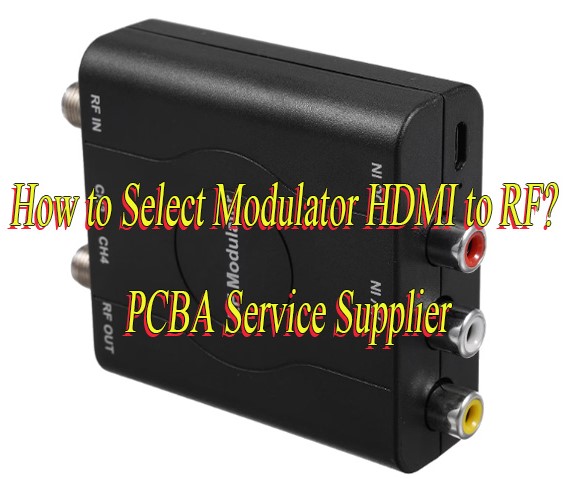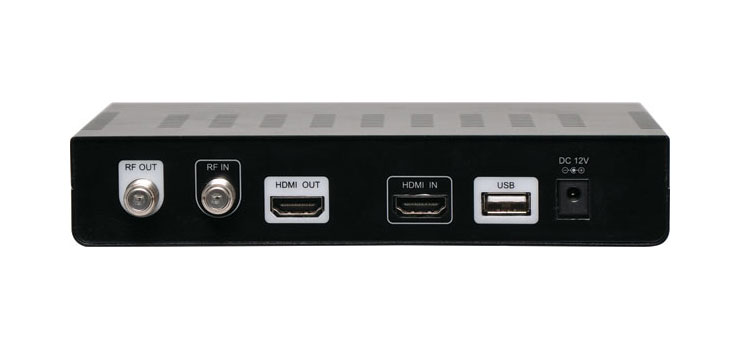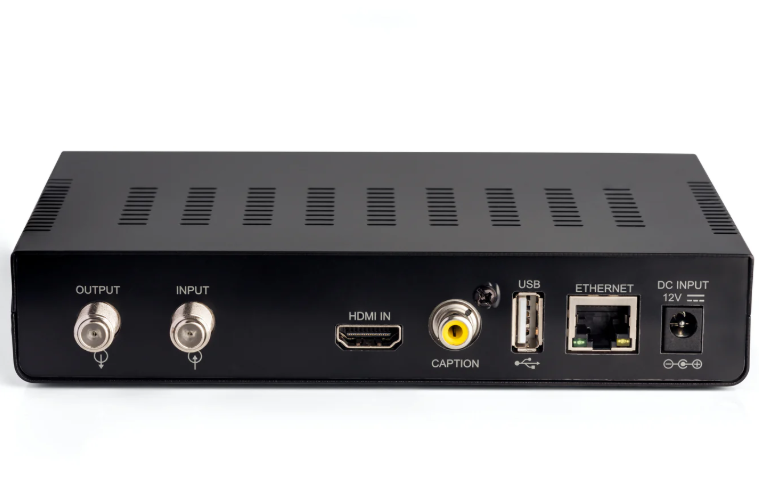How to select modulator HDMI to RF? Let’s discover benefits, selection guide, technical specification, working process, usage method, purchasing guide for modulator HDMI to RF.
Are you worried about these questions?
- Tired of mosaic or snowy screens during HDMI-to-RF signal conversion?
- Struggling to maintain consistent impedance matching across mass-produced PCBs?
- Frustrated by delayed deliveries for small-batch or urgent orders?
As a professional PCBA service supplier, Best Technology can provide you service and solution:
- Microvia layered isolation cuts signal attenuation by 40%, eliminating interference for flawless visuals.
- 7-day prototyping + 15-day mass production with ±3% impedance accuracy, doubling industry consistency benchmarks.
- Full-chain support from schematic optimization to 45MHz-860MHz frequency band tuning, ensuring true plug-and-play stability.
Welcome to contact us if you have any request for modulator HDMI to RF: sales@bestpcbs.com.
âWhat is a Modulator HDMI to RF?
A HDMI to RF modulator is a device that converts HDMI digital signals to RF analog signals. It primarily connects modern AV sources such as set-top boxes and game consoles to older TVs or broadcast systems. Its core function uses MPEG-4/H.264 encoding and DVB-T modulation technology to transform 1080P video and multi-channel audio into TV RF standard-compliant signals. The output frequency typically covers 350-860MHz.
This device is widely applied in home theater retrofits, hotel TV systems, and surveillance signal transmission scenarios. It supports traditional TV connection via coaxial cables, enabling compatibility between new and old devices.

Why Choose HDMI to RF Modulator?
Benefits of HDMI to RF Modulator:
- Compatibility with Legacy Devices: Avoid replacing older TVs or monitors. HDMI to RF modulators enable legacy devices to receive high-definition HDMI signals directly, saving upgrade costs and revitalizing existing equipment.
- Multi-Room Coverage: RF signals penetrate walls, allowing simultaneous signal distribution across multiple rooms (e.g., syncing living room TV to bedrooms/kitchens) for seamless family entertainment sharing.
- Plug-and-Play Simplicity: Easy installation without professional setupâconnect devices quickly with minimal wiring, eliminating complex technical adjustments and saving time/labor costs.
- High-Definition Transmission: Supports 4K/1080P HD signals for crisp, smooth visuals, meeting modern demands for high-quality viewing experiences.
- Cost-Effective Solution: Significantly lower investment compared to full device replacement or extensive rewiring, delivering compatibility and signal expansion at unmatched value.
- Stable Signal Integrity: RF transmission technology ensures strong anti-interference capabilities and reliable signal stability, preventing lag, freeze-frames, or signal loss for consistent premium viewing.
How to Select Modulator HDMI to RF?
A guide to how to select modulator HDMI to RF:
1. Core Parameter Matching
- Resolution & Encoding: Select devices supporting 1080P/60Hz or higher resolution with H.264/H.265 encoding for lossless HD video conversion. For 4K content, confirm HDMI 2.0/2.1 compatibility for high-bandwidth transmission.
- Modulation Standards: Choose regional broadcast standards like DVB-T (Europe/Asia), ATSC (Americas), or ISDB-T (Japan/South America) to avoid signal reception issues.
- Frequency Range: Ensure output covers 350-860MHz and matches local UHF/VHF bands (e.g., 470-860MHz in China) for full channel coverage.
2. Interface & Expandability
- Input Compatibility: Verify HDMI versions (1.4/2.0/2.1) for HDR and dynamic range support. Check for HDMI pass-through for multi-screen setups.
- Audio Processing: Support multi-channel audio (AC3/DTS) passthrough or stereo conversion for legacy TVs. Validate digital audio inputs (optical/coaxial).
- Output Expansion: Standard F-type coaxial RF output with signal splitter compatibility for multi-device distribution (hotels/surveillance).
3. Scenario-Specific Features
- Home Use: Prioritize one-touch channel search and automatic gain control (AGC) for ease of use.
- Commercial Use: For hotels/surveillance, opt for batch channel allocation and encryption (SCPC/MCPC) to prevent conflicts. Surveillance requires long-range anti-interference.
- Legacy Compatibility: Support analog standards (PAL/NTSC/SECAM) for older black-and-white/color TVs.
4. Signal Quality & Stability
- SNR Standard: â„45dB SNR ensures noise-free video/audio. Test weak-signal resilience.
- Anti-Interference: Built-in filtering reduces WiFi/wireless device interference. Metal casing + active cooling enhances stability.
- Stability Testing: Validate range tests for consistent quality and coverage.
5. Cost Efficiency & Warranty
- Value Assessment: Compare prices while noting hidden costs (power adapters, remotes). Balance performance and long-term costs.
- Brand & Certification: Choose CE/FCC-certified brands. Review user feedback on warranty (1-3 years) and support responsiveness. Avoid uncertified brands.
6. Installation & Verification
- Plug-and-Play: Auto-input detection simplifies setup. Verify quick channel setup and remote control.
- Real-World Testing: Request demo videos or test range/stability pre-purchase.
7. Additional Features & Reputation
- Smart Features: Remote control, app tuning, and LED indicators enhance convenience. Validate functionality.
- User Reviews: Check e-commerce/forums for real feedback on stability, compatibility, and support. Avoid low-rated products.

HDMI to RF Modulator Technical Specification
| Parameter Category | Technical Specification Details |
| Input Resolution | Supports 1080p/60Hz full HD, broadcast-grade devices compatible with 4K H.265 encoding, suitable for modern HD source devices (e.g., Blu-ray players, gaming consoles) |
| Output Frequency Range | Standard models cover 47-870MHz (UHF/VHF), professional models support 50-1218MHz wideband, compatible with unused CATV channel injection |
| Modulation Type | Integrated 8VSB (ATSC), DVB-T/COFDM, QAM (64/256), NTSC/PAL/SECAM and other global mainstream standards, adaptable to regional TV systems |
| Signal Strength | Output level 49-79 dB”V (adjustable), typical value +25dBmV, ensuring long-distance transmission stability and superior anti-interference compared to traditional analog signals |
| Interface Configuration | HDMI Type A input (supports HDCP 1.2/2.2), F-type coaxial output, some models include RF loop-through I/O and USB media playback interfaces |
| Power & Consumption | 5VDC 2A (standard) or 8-32V wide-voltage supply (industrial), power consumption as low as 10W, suitable for automotive/outdoor scenarios |
| Environmental Adaptability | Operating temperature -40°C~85°C, wide-temperature design for extreme environments, harmonic distortion <-20dBc, RF power contrast â„50dB |
| Physical Dimensions | Compact design (e.g., 1-3/8″Ă9-1/2″Ă4-3/4″), 1U/2U rack-mountable, fits server rooms or home equipment cabinets |
| Audio Encoding | Supports MPEG1 Layer II, AAC, HE-AAC, AC3 passthrough with audio gain adjustment, compatible with multi-channel stereo transmission |
| Transmission Performance | Maximum distance 700m (RG6 cable + 64QAM), latency as low as 70ms, supports PID remapping/PSI/SI editing and multi-channel OSD overlay |
| Intelligent Features | Web-based management, PID remapping, PSI/SI editing, multi-protocol output (UDP/RTP/RTSP), supports remote monitoring and automation |
| Compatibility & Expansion | HDCP 1.2/2.2 compliant, compatible with CATV systems, supports hybrid transmission with satellite/cable signals, suitable for distributed deployments in hotels/hospitals |
How Does an Modulator HDMI to RF Work?
1. Signal Input and Decoding: Receives digital signals from HDMI source devices (e.g., set-top boxes, computers), decodes and separates video frames, audio streams, and control data via dedicated chips, ensuring lossless extraction of original content.
2. Baseband Signal Adaptation: Converts HDMI’s TMDS signal into baseband format compliant with TV standards, including color space conversion (e.g., RGB to YCbCr), frame rate synchronization (e.g., 60Hz to 50Hz), and audio resampling to match RF transmission requirements.
3. RF Carrier Modulation: Generates an RF carrier at a specific frequency (e.g., UHF band 470-860MHz) and embeds baseband signals using modulation techniques like QAM/FM, enabling efficient high-frequency signal transmission.
4. Channel Configuration and Interference Avoidance: Uses programmable circuits to set output channels (e.g., CH28-69) and employs intermediate frequency filtering to avoid local broadcast signal interference, ensuring signal purity in multi-device environments.
5. Power Amplification and Output: Amplifies the modulated RF signal via a power amplifier and transmits it through coaxial cables (e.g., RG-6) to TVs or receivers, supporting both analog/digital dual-mode output for compatibility with old CRT TVs and smart TVs.
6. Bidirectional Communication Support: Some models integrate protocols like HDCVI, allowing bidirectional interaction (e.g., reverse transmission of remote control signals) via RF cables for device-to-device communication.
7. Scenario-Based Applications: Typical use cases include upgrading old TVs to support HD signals, multi-room video distribution in hotels/hospitals, and long-distance transmission of security monitoring signals, addressing compatibility between digital devices and traditional RF networks.
How to Use Modulator HDMI to RF?
1. Device Connection Steps
- Input Connection: Connect the HDMI output of the source device (e.g., set-top box, gaming console, computer) to the HDMI input of the modulator. For multi-signal processing, choose modulators with multi-input support (e.g., 12-channel or 16-channel models).
- Output Connection: Link the modulator’s RF output port to the TV or receiver’s antenna input (labeled “RF IN” or “ANTENNA”) via a 75Ω coaxial cable to minimize signal loss.
- Power & Auxiliary Connections: Ensure the modulator is powered by a stable source (supporting 8-32V wide voltage input). For remote control, connect the remote receiver if applicable.
2. Channel Setup & Tuning
- Output Channel Selection: Configure the output channel via the modulator panel or remote control (e.g., UHF 38-69 channels or VHF 2-13 channels). Select unused channels based on local TV frequency allocation to avoid signal conflicts.
- TV Tuning: Power on the TV, access “Channel Search,” and select “Auto Search” or manually input the modulator’s channel number. For older TVs, confirm compatibility with standards like NTSC, PAL, or SECAM.
- Signal Optimization: Adjust the modulator’s output power (e.g., 6Watts) or use a signal amplifier if weak signals occur. Avoid long coaxial cable runs to prevent signal attenuation.
3. Compatibility & Technical Parameters
- Signal Format Support: Verify the modulator supports input resolutions (e.g., 1080p, 4K) and audio codecs (e.g., AC3, AAC, HE-AAC). Premium models may include H.264 encoding and OSD overlay (e.g., text/QR code insertion).
- Standard Matching: Select modulators aligned with regional standards (e.g., DVB-C/T for China, NTSC/ATSC for the US/Europe).
- Impedance Matching: Ensure coaxial cables are 75Ω, and modulator input/output impedances match (e.g., 50Ω analog input, 10kΩ digital input) to prevent signal distortion.
4. Debugging & Troubleshooting
- Signal Testing: Check TV clarity post-connection. If snow or noise appears, inspect connections, verify channel settings, or replace cables.
- Interference Mitigation: Keep modulators away from strong EMI sources (e.g., microwaves, Wi-Fi routers). Use wideband signal splitters (e.g., 6MHz bandwidth support) for distribution.
- Advanced Features: Leverage PID remapping, PSI/SI editing, or web-based management (e.g., via official manuals or tech support) for specialized setups.
5. Precautions & Maintenance
- Power Safety: Use stable power supplies to prevent voltage fluctuations. Wide-voltage models (8-32V DC) suit mobile/vehicular use.
- Thermal & Environmental Care: Place modulators in well-ventilated areas, avoiding direct sunlight or humidity.
- Regulatory Compliance: Confirm local radio regulations before use. Some regions require permits for specific frequency bands.

Where I Can Buy HDMI to RF Modulator?
1. Global E-Commerce Direct Purchase
- Amazon Global: Search “HDMI to RF Modulator” on Amazon.com. US listings include Rocketfish RF-G1175 (supports 1080p, ~$9-15 with international shipping). Opt for “Amazon Global” labeled items for direct shipping and pre-calculated duties. EU buyers can use Amazon.de/.co.uk with DHL direct delivery.
- eBay Global: Search “HDMI to RF Converter” with “Worldwide Shipping” filter. Shenzhen Kaiying RF-HD1080P (supports dual PAL/NTSC, $30-50 shipped) is recommended. Verify seller ratings (â„95%) and return policies.
2. Specialist Electronics Retailers
- Newegg International: Search “HDMI RF Modulator”. WUQ 4K Wireless HDMI Extender (5G transmission, 100ft range, $145 shipped) suits wireless needs.
- B&H Photo Video: Thor PETIT HDMI RF Modulator supports 4K input and EU/US standards, with DHL shipping ($20-50) and 2-year warranty.
3. Manufacturer Direct Channels
- China OEMs: Shenzhen Lekunxuan Video Tech (verified via Aichacha) offers DTMB/ATSC dual-standard modulators ($300-500 shipped) with bulk customization (10+ units). Ideal for engineering projects.
- Brand Authorized Dealers: Sony/Panasonic/Philips models available via authorized dealers (e.g., Philips EasyLink adapters, $50-100) with HDMI CEC control.
4. Localized E-Commerce Platforms
- UK Argos: HDTV Labs converters (supports Freeview, ÂŁ40-60) with same-day delivery.
- Germany Otto: Audiovox AVM series (DVB-T/C standard, âŹ50-80) with cash-on-delivery and 14-day returns.
- Japan Yodobashi: Elecom 4K converters (around $850-$1450) with in-store pickup.
5. Wholesale & Distribution Channels
- Alibaba International: Search “HDMI to RF Modulator” with “Gold Supplier” filter (e.g., Shenzhen Yingmu RF-HD1080P, $15-30/unit, MOQ 10). Supports T/T/L/C payments and CE/FCC certifications.
- Global Sources: Dongguan Xinlian Electronics offers OEM customization ($20-40/unit) with international logistics.
6. Logistics & Tariff Guidance
- Shipping: DHL/FedEx (3-7 days, 20â50)forsmallorders;seafreight(30â45days,5-10/kg) for bulk (â„50 units).
- Tariffs: EU VAT ~20%, US duties ~2.5%-5% (HTS code 8528.12). Opt for DDP (Delivered Duty Paid) to avoid customs delays.
7. After-Sales Support
- Warranty: International sellers offer 1-2 year warranties (e.g., Amazon Global supports local returns). Confirm overseas warranty coverage (e.g., Sony only covers origin country).
- Tech Support: Prefer sellers with English support (e.g., B&H 24/7 chat, Newegg forums).
Welcome to contact us if you have any request for HDMI to RF Modulator: sales@bestpcbs.com.


